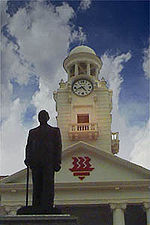Arcadia Road
Arcadia Road is secondary road in Singapore which was designated as a heritage road in 2005. Starting at a junction of Adam Road, it extends for 918 metres before ending. The road is lined with rain trees and is known for its lush greenery.Prior to the construction of the Pan Island Expressway, Arcadia Road existed as a curving track between the neighbouring hills. It connected users to the paths behind the Eng Neo private estate. The present road skirts past the colonial era Adam Park Estate. It is located amidst the secondary forest near the MacRitchie Reservoir. In 2005, the road was gazetted as a heritage road, which earmarkes a 10 metre wide green buffer (on the sides of the road) for conservation.The sides of the road are lined with mature rain trees as well as condominiums like Hillcrest Arcadia and The Arcadia.
Excerpt from the Wikipedia article Arcadia Road (License: CC BY-SA 3.0, Authors).Arcadia Road
Arcadia Road, Singapore Bukit Timah
Geographical coordinates (GPS) Address Nearby Places Show on map
Geographical coordinates (GPS)
| Latitude | Longitude |
|---|---|
| N 1.3347222222222 ° | E 103.81016666667 ° |
Address
Hillcrest Arcadia Shops
Arcadia Road 251
289847 Singapore, Bukit Timah
Singapore
Open on Google Maps







